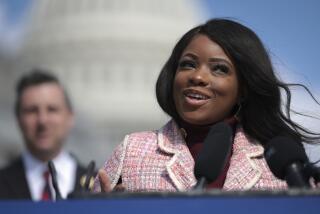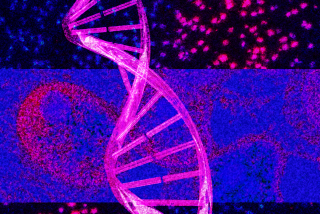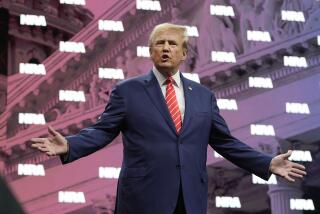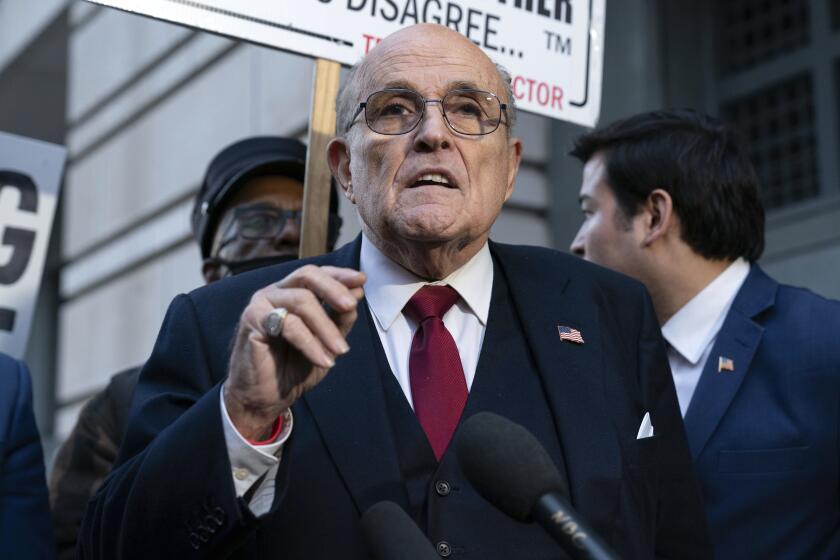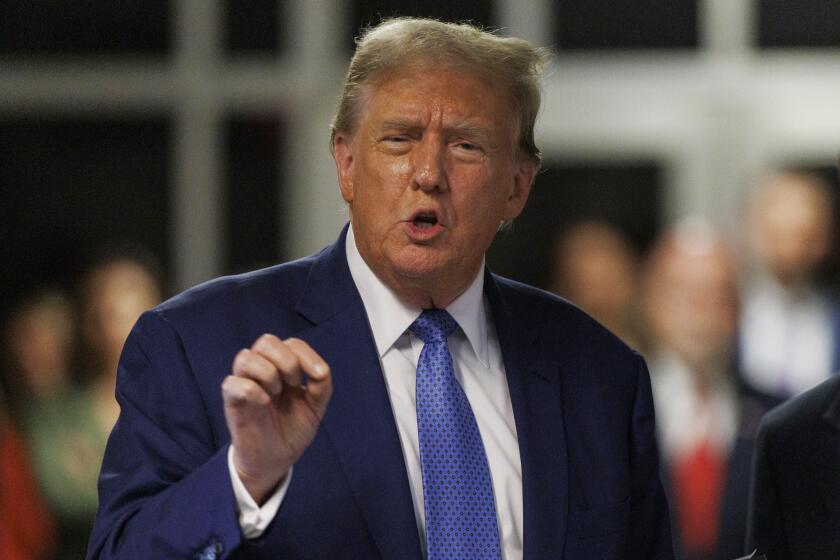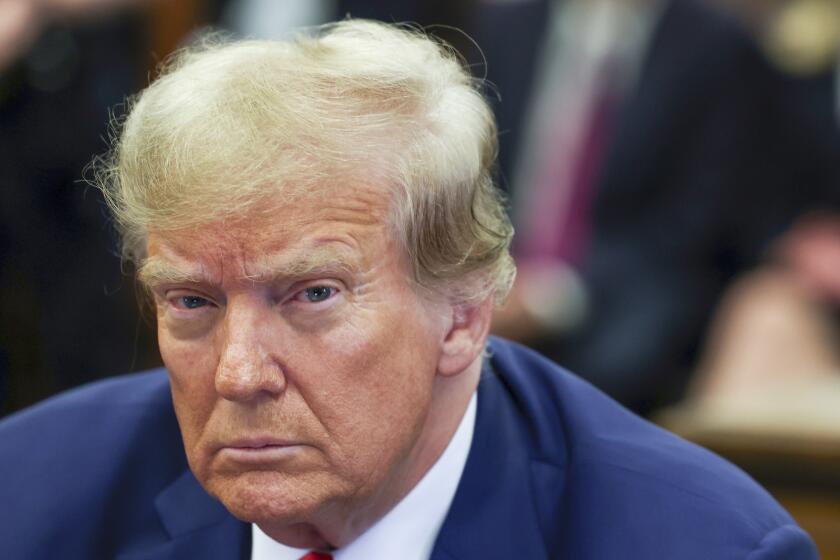House, in a Near Party-Line Vote, OKs Bush Budget
A deeply divided House approved a $1.94-trillion budget Wednesday for the coming year that ratifies President Bush’s plans to slash taxes and curb spending, sending the blueprint to the Senate, where it faces far tougher sledding.
House passage of the budget resolution, which came on a virtual party-line vote of 222 to 205, is the opening move in a long and contentious process to shape the fiscal policy of Bush’s first year in office.
“Some budgets are more important than others,” said Rep. John M. Spratt Jr. (D-S.C.). “This year is a watershed. It will determine the path we take for years to come.”
Republicans rallied behind the budget resolution as an emblem of Bush’s push for a more limited government.
“The choice is between two visions,” said House Majority Leader Dick Armey (R-Texas). “A choice between larger and larger taxes or a choice of smaller government that trusts the people.”
Still, the bloc vote by Republicans for the budget plan masks misgivings many harbor about the spending limits the White House has set in such areas as agriculture and defense, and about the size and composition of Bush’s proposed $1.6-trillion tax cut.
Those concerns may not have slowed House approval of the budget document, but they pose a serious challenge to it in the Senate, which takes up the fiscal plan next week. GOP leaders have asked Vice President Dick Cheney to be on hand all week in the event they need his vote to break a tie in a Senate evenly split between the parties.
“It’s going to be a very difficult job,” Senate Budget Committee Chairman Pete V. Domenici (R-N.M.) said Wednesday at the White House after GOP leaders met with Bush.
At that meeting, the president and top Republicans reaffirmed their commitment to enacting an immediate tax cut this year to help stimulate the economy--but insisted that it would have to be linked to Bush’s broader tax cut.
“We’re going to provide relief this year but also every year,” said Rep. Christopher Cox (R-Newport Beach).
Annual Spending Put at 4% in Plan
The House budget resolution embraces the broad outlines of Bush’s plan for the fiscal year beginning Oct. 1. These include:
* The $1.6-trillion tax cut over 10 years.
* An overall 4% increase in annual spending, compared with an 8% increase agreed to by then-President Clinton and Congress for the current fiscal year.
* A $310.5-billion budget for the Defense Department, an increase of 4.8% over its current spending.
* Using $2.3 trillion of the expected $5.6-trillion surplus over the next 10 years to reduce the national debt.
But House Republicans expressed qualms about some elements of the Bush agenda. For instance, the budget resolution does not call for passage of Bush’s initiative to open Alaska’s Arctic National Wildlife Refuge to oil and gas drilling. That does not prevent Congress from acting on the measure as separate legislation later this year, but its omission from the budget is a sign of how much trouble it may face.
“That was a battle we didn’t want to fight in the budget,” said House Budget Committee Chairman Jim Nussle (R-Iowa).
Other Republicans worried that Bush’s plan would leave some departments inadequately funded. Many were disappointed that a bigger increase was not provided for the Pentagon. But Bush said he would not propose a big expansion in defense spending until his administration completes a wide-ranging review of the Pentagon’s needs and programs.
“That leaves us in a difficult position,” said Rep. Duncan Hunter (R-El Cajon). “Everybody realizes we are going to have to increase it.”
Some Disappointed Over Lower Farm Aid
Farm-state lawmakers are dismayed that Bush’s budget called for only $17.9 billion for the Agriculture Department--down from $19 billion this year--and lobbied GOP leaders to make room for more spending at a time when the farm economy is ailing.
Such concerns were finessed by the inclusion in the House budget resolution of a $517-billion “contingency fund” set aside over 10 years that could be tapped if Congress decides later this year to spend more for some agencies. The fund could also be drawn on to pay for establishing a prescription drug benefit for Medicare beneficiaries.
Democrats reiterated their arguments that the Bush tax cut proposal would leave too little for other programs, including reform of Medicare and Social Security, and risked plunging the federal government back into deficit spending.
Some conservative Republicans countered that the Bush budget plan would allow spending to increase too much in many areas. But their alternative proposal was rejected, 341 to 81.
Also rejected--by a vote of 243 to 183--was the Democratic leadership’s alternative, which would provide a smaller tax cut, more debt reduction and more money for education and Medicare prescription drug benefits. It included a $60-billion tax cut this year to stimulate the economy.
On the final vote to pass the budget resolution, only three Democrats broke party ranks to support the Bush plan, while only two Republicans joined the opposition. The Democrats who backed the budget included Rep. Gary A. Condit of Ceres; otherwise, the votes by California House members adhered to party lines.
As the debate shifts to the Senate, GOP leaders are hoping to win over wavering Republican moderates by including a provision to allow Congress to review tax cuts in the future if the budget surplus comes in smaller than estimated.
Senate leaders also will face added pressure to bump up spending for some programs. For instance, Senate Appropriations Committee Chairman Ted Stevens (R-Alaska) predicts that efforts will be made to increase spending for education and basic scientific research.
“There are areas of concern that are going to require adjustment,” Stevens said.
More to Read
Get the L.A. Times Politics newsletter
Deeply reported insights into legislation, politics and policy from Sacramento, Washington and beyond. In your inbox three times per week.
You may occasionally receive promotional content from the Los Angeles Times.
